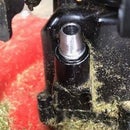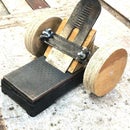Introduction: Stripped Knobs and Pulls
It is not fun to deal with knobs and pulls with stripped threads so that the knob or pull come off of the drawer or door when grasped, yet it happens frequently.
Many at Instructables have dealt with this often in their time. This is for the person who has the problem, but does not know what to do about it.
Step 1: The Problem and One Solution
The threads strip out in the first 1/8 inch or so of the threaded post on the backside of the knob or pull. Many simply insert part of a paper matchstick into the hole and twist it back onto the screw. This may last for a very short time, but eventually fails.
Step 2: The Real Solution
The entire length of the post on drawer hardware is threaded. Push a toothpick into the hole and pinch it with your fingernail to indicate the length of the threaded portion inside the post. The distance from where your fingernail pinches the toothpick to the end of the toothpick is the ideal amount of threads to extend beyond the finished surface of the cabinet wood. You really want to shorten this distance by about a millimeter or two in order to allow a little free space for tightening the knob on the screw. Add to the amount of thread extending beyond the finished wood surface the thickness of the cabinet door or the drawer front. You may also need to add the thickness of a washer. See the next step.
Step 3: Small Head?
The screwhead on the left is the screw removed from the knob or pull. The screw on the right is a standard screw from the hardware store. Notice that its head is smaller than the original screw. Adding a washer gives it better support against the wood on the back side of the door or drawer front and is a good idea, but it also adds a little thickness that needs to be considered in preparing a screw for your knob or pull.
Step 4: A Handy Tool Worth Having
The photo shows a wire stripper tool for household electrical work. These are available in many tool departments, particularly in the electrical tools at a big box store. They are not expensive to buy.
Although useful for stripping wire sizes commonly used in homes and for pinching crimp connectors, this one also has five holes on each side of the tool for cutting screws of different common sizes without damaging their threads. The screws for cabinet hardware are 8-32 in thread size (#8 diameter screw, 32 threads per inch).
Step 5: Insert the Screw From the Proper Side
You will not likely be able to buy a screw the exact length you need. Buy a screw that is a bit longer than you need and plan to cut it. Twist the screw into the proper hole on the threaded side of the tool. That would be the side with the threads, not the side that has smooth holes. Notice that there is even an instruction to the user that says, "Insert screw here."
If you were to insert the screw from the other side, the threads would be damaged in cutting the screw to length.
Step 6: Cutting the New Screw to Length
Twist the screw into the tool so the screw will be cut at the proper length. This is indicated by the yellow arrow. Try to be as accurate with this as possible. If anything goes wrong, you can always buy another screw and try again, though. When you are ready, firmly squeeze the handles on the tool and the screw will be pinched off. Turning the screw back out of the tool will make the threads at the end of the freshly cut screw as factory new as possible.
Step 7: The Results
On the left you see an original cabinet hardware screw. On the right you see a freshly cut replacement screw. It is just enough longer to catch fresh threads in the stripped cabinet knob or pull. See also the second photo, which shows the original screw in the cabinet door; and the third photo, which shows the new freshly cut replacement screw. Some of the old stripped threads are only partially stripped and will add some additional gripping power.
You will have saved your knob or pull, which may no longer be available new in the pattern you have on the rest of your cabinets. Cutting a new, longer screw can get you out of a difficult situation.
If your knob is still too loose after cutting to length, you could add extra washers to the head to take up the extra and make it tight. If the screw does not grab enough threads after cutting, you could drill out the back of the door or the drawer front using about a 1/2 inch bit to gain some length. But, both of these are "desperate measures" for getting out of a special, very difficult problem.













